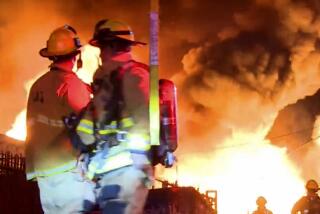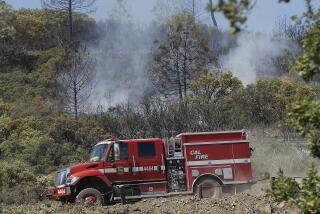Young Arsonists: Therapy Tries to Quell the Urge
Brian liked to set fires.
When he was 4, it was a trash can fire that filled the family apartment with smoke. By 7, he had set several small fires at school. And soon after his 10th birthday, he ignited a major blaze at a mental health clinic that destroyed several offices and caused $35,000 in damages.
Depression, neglect and lack of self-esteem all fueled his habit, say doctors at several institutions where Brian has lived off and on since he was first hospitalized six years ago.
Returning home from the various treatment centers has not been easy for Brian--or for his mother, who admits that it is difficult to trust a firesetter, even when he’s your own.
Now 13, Brian is close to going home again, this time from College Hospital, a private psychiatric facility in Cerritos.
Brian was one of the first youngsters enrolled in College Hospital’s Firesetters Program, which was created last fall as a result of a rapid rise in reported juvenile arson.
Arson has increased 325% nationwide in the last decade, the FBI reports, and more than half of the arrested arsonists are under 18. Even more disturbing, authorities claim that one of every 10 juvenile arsonists is under 10. Eighty percent of all juvenile firesetters are males, and most are white.
Brian’s psychologist said he is no longer one of those statistics, thanks in part to the Firesetters Program.
Craig Stempf, a Long Beach clinical psychologist, said he believes that Brian’s fascination with fire has ended because of intense therapy and fire-safety education through books, films, games and visits by firefighters.
“He is more laid-back these days,” Stempf said, “much more comfortable with who he is and how he fits into society.
“Setting fires was a way to release rage to get back at the world, particularly for a youngster who felt powerless to guide his own life or command attention.”
Brian, whose mother asked that his real name not be revealed, agrees that the thrill is gone from setting fires.
“That’s something I used to do, when I was a kid,” he said during a recent interview at Stempf’s Long Beach office. For Brian, firesetting no longer holds the “excitement, the charge,” it once had, Stempf said.
Brian simply said: “It’s boring. . . .”
Brian, who has been at the 125-bed hospital since September, is one of eight juveniles receiving special care for firesetting. Ninety to 100 juveniles are enrolled in the program as outpatients.
College Hospital is one of the few inpatient psychiatric facilities in Southern California that admits known juvenile firebugs, fire safety experts say. Often, treatment centers fear that habitual firesetters will destroy the institution with one strike of a match. Others are reluctant to treat firesetters because of problems with liability insurance and safety complaints from other patients or their parents.
“There is a severe shortage of long-term centers for heavy-duty firesetting kids,” said Pam McLaughlin, founder of the San Francisco-based, nonprofit Firehawk Foundation, which teams firesetters with firefighters in an adaptation of the Big Brother idea.
“We get calls from all over the country about where to send these kids,” she said. “Frankly, the options are few. Foster homes don’t want them. Most government-funded programs don’t want them. And sadly, the parents are usually too scared to keep them.”
About 1 million arson fires were reported nationwide in 1984, and about half of those were set by juveniles. In California alone, there were about 50,000 arson fires that year, resulting in more than $160 million in damages, 500 injuries and 21 deaths. Los Angeles fire officials estimate that property loss resulting from arson in 1984 topped $31 million--about half of that caused by juveniles.
“Ten years ago we rarely suspected children when it came to arson,” said Capt. Joe Day of the Los Angeles County Fire Department’s fire education unit. “Today it is the fastest-growing statistic. Arson is so easy for children to commit--and unfortunately so deadly.”
‘There Is a Stigma’
Since College Hospital opened in 1972 just west of Cerritos College, hundreds of juveniles, ages 4 to 18, have been treated for a range of emotional or mental health problems. Firesetting was among the problems, said Robert Myers, director of the hospital’s pre-adolescent and children’s programs. But the rise in reported juvenile arson persuaded Myers and other hospital officials to establish and market a separate program specifically for firesetters.
For Brian and others like him, firesetting is the result of a complex set of emotional and psychological problems. Repeatedly setting fires, Stempf said, is usually a signal of a deeper disturbance.
More to Read
Sign up for Essential California
The most important California stories and recommendations in your inbox every morning.
You may occasionally receive promotional content from the Los Angeles Times.










